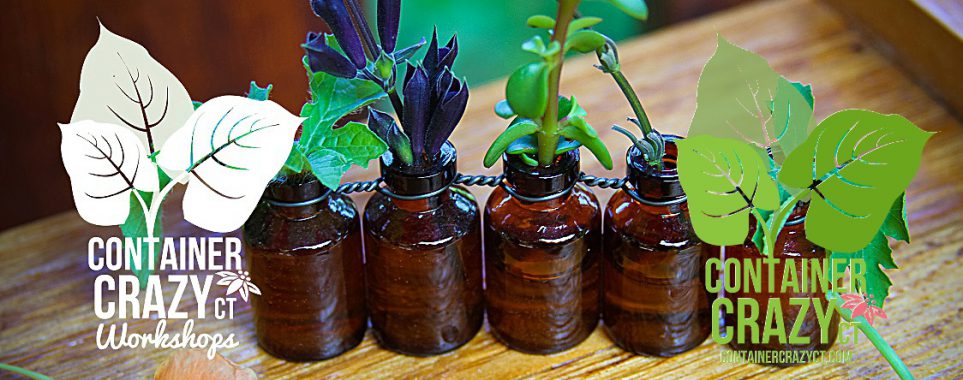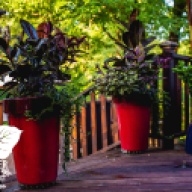If you haven’t been introduced or seen the annual, Persian Shield, you are missing out on one of the most amazing purple colored foliage plants to use in container gardens.

Persian shield (Strobilanthes dyerianus) enjoys full to part sun and will grow to about 18-36″ tall. It has an upright habit, makes an excellent filler, and is an annual plant except for zones 9-11. In CT, we are zone 6.

In a part sun situation, under patio umbrellas, these plants performed beautifully this season for me at home. However, I also have installed them in full sun situations at client sites (photos on those later) this year, and they performed equally well because they are heat tolerant too. I guess you could say, this plant is very versatile.

As a container garden installer, sometimes I will have some left over plants and assemble them at home in random fashion. Thus, this year, I put together 3 plants you may not consider would “work well” together for design purposes, but they did. They were a darker variety of rubber plant, Persian Shield, and mint.

The mint served as a cascading spiller (and was handy to cut from for summer cocktails), the rubber plant served as the large and tall thrillers, and the Persian Shield was the filler (and is of a perfect height with the rubber plant which grew taller).

I tend to enjoy foliage plants over flowering. Foliage lasts a long time (still going strong right now in mid-September) and adds a great deal of texture. In the case of Persian Shield, it has the narrow shaped leaves with pointy ends and the leaf veins and the somewhat ruffle texture on the leaf itself gives it a sense of ambiance.

These two patio pots with Persian Shield graced the steps leading to the top level of my deck. When friends came by, they always stopped to not only comment on the Persian Shield’s coloring and beauty, but they also would reach down to touch the leaves with their finger tips. This is a true sign of a plant that is captivating.
The rubber plant’s darker toned and larger sized leaves gave the Persian Shield’s coloring a bit more impact but this plant also pairs well with softer colors, like pinks or softer purples, which is a combination I put together at a client’s full sun patio site this season (and will show photos of that combo later).
I have found the coloring of Persian Shield is best in the part-sun situations, but I would never limit it to only part sun. It tolerates the full sun situations. I watered these two pots regularly and the soil remained moist most times, although one should always be sure to not over water anything to the point of soggy. The nice thing about Persian Shield is it can take low water use as well. Again, easy and versatile.
This plant may be overwintered as a house plant, which I have not done myself, or you may take tip cuttings to root in water and hopefully keep it going to replant next season, or just run to the nursery in the spring time to get some more because Persian Shield is worth it.
In a future post, I will share more photos of how I used this plant and post about the rubber plants used in these combinations soon. They have an interesting story to go with them.
In the meantime, enjoy the purplelicious nature of this wonderful primarily foliage plant (Note: It does bloom light purple flowers eventually but they are not very showy).
Thank you,
Cathy Testa
Container Crazy CT
860-977-9473
Broad Brook, CT
P.S. The beautiful photos in this post were taken by JMSArtandPhoto









Loveddddddddddddd those containers along with the GIANT ones on your deck !!!
________________________________
THANK YOU THANK YOU. I love them too. Will be posting about the big cylinder planters soon.